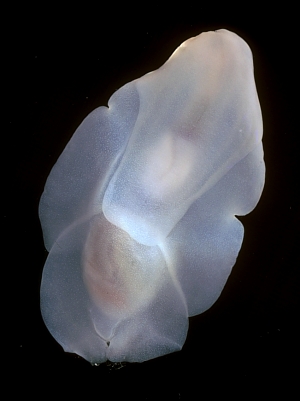
Philine angasi
(Crosse & Fischer, 1865)
Order: CEPHALASPIDEA
Family: Philinidae
DISTRIBUTION
Common in southern Australia and northern New Zealand.
PHOTO
Locality: Eyre Peninsula, South Australia, February 1985. Photo: Bill Rudman.
The opaque white calcareous gizzard plates can be seen in the centre of the body. The shell is internal but its size and shape can be seen in the posterior half of the body where it encloses the viscera. Philine angasi and P. aperta are two of a group of species in which the body has become solid, muscular and wedge-shaped, presumably for burrowing through soft sediments.
See message below [#176 ] for information on its anatomy and biology.
- Rudman, W.B., 1970. A revision of the genus Philine in New Zealand with descriptions of two new species (Gastropoda, Opisthobranchia). Journal of the Malacological Society of Australia 2(1): 23-34.
- Rudman, W.B., 1972a. Structure and functioning of the gut in the Bullomorpha. (Opisthobranchia) Part 3. Philinidae. Journal of Natural History 6(4): 459-74.
- Rudman, W.B., 1972b. The genus Philine (Opisthobranchia, Gastropoda). Proceedings of the Malacological Society of London, 40(3): 171-87.
Rudman, W.B., 1998 (July 30) Philine angasi (Crosse & Fischer, 1865). [In] Sea Slug Forum. Australian Museum, Sydney. Available from http://www.seaslugforum.net/find/philanga
Related messages
Philine angasi from Shark Bay, Western Australia
March 16, 2009
From: Patricia Heithaus
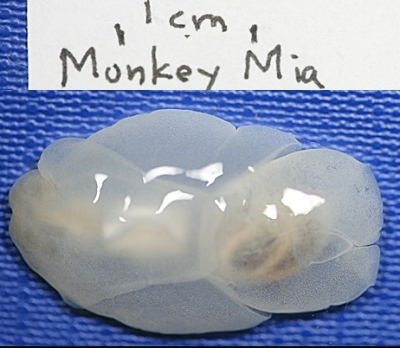
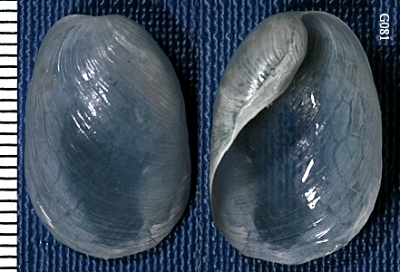
Dear Dr. Rudman,
Several specimens of Philine sp. were collected as part of the Shark Bay Ecosystem Project on the feeding of rays on the intertidal flats near Monkey Mia, WA. I am enclosing photos taken in early July 2008 in hopes that you might be able identify the images to species. Philine were fairly common on the tidal flats and showed almost a two fold variation in size.
Locality: Monkey Mia, Shark Bay, West Australia. Intertidal Flats. approx 25 mm long alive. 16 June 2008. Photo: Patricia Heithaus
I can provide pictures of a higher resolution if they would be helpful. I also have a short video of a burrowing specimen.
Thank you for your assistance in this matter.
Sincerely,
Patricia Heithaus
Heithausp@kenyon.edu
Heithaus, P., 2009 (Mar 16) Philine angasi from Shark Bay, Western Australia. [Message in] Sea Slug Forum. Australian Museum, Sydney. Available from http://www.seaslugforum.net/find/22332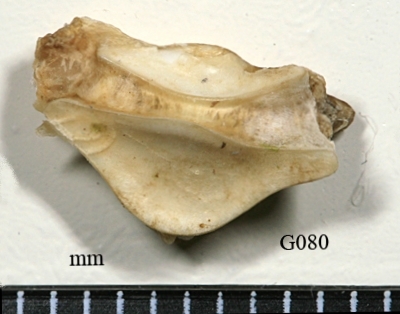
Dear Patricia,
This is almost certainly Philine angasi. This species was originally thought to restricted to New Zealand and southern Australia but there is nothing to separate southern animals from those that have been found in southern Queensland and Western Australia. This species is one of a group with a very thin flattened shell, a very muscular wedge-shaped body, and large calcareous gizzard-plates, two of which are mirror images of each other and the third which is much smaller and bilaterally symmetrical [message #176]. Similar species are found in Europe - Philine aperta, and the northwest Pacific - Philine orientalis.
I would be interested to know if the rays were feeding on the Philine. We have little information on what eats various opisthobranchs and I suspect there is more hidden in scientific reports on the predators. I don't think the digitisation of the world has yet reached the stage where I can Google up lists of prey animals found in the stomach contents of potential predators of opisthobranchs. So if you can short-circuit the process I would be grateful.
I am not sure what you mean by 'a two fold variation in size'. Do you mean their are two size classes or a range of animals from 25 mm to ? Most species of Philine seem to have an annual life cycle, but some of the bbigger species, like P. angasi can last for two or three years. You may have two generations of P. angasi in your sample or you may possibly have two species. The shape of the shell and degree of calcification are two species specific characters to look our for. The other is the shape and degree of calcification of the gizzard plates. Most species have three equal sized and shaped plates. P. angasi is somewhat unusual in its unequal gizzard plates.
Best wishes,
Bill Rudman
Philine angasi from Bruny Island, Tasmania
November 24, 2008
From: Julie Marshall
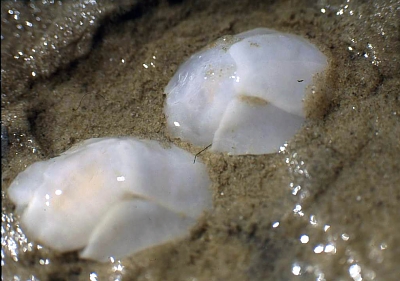
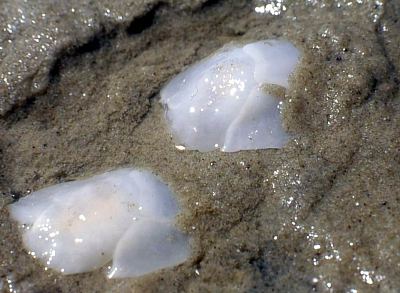
Concerning message #22053:
Dear Bill,
Following Gary Cobb's message about finding Philine angasi in southern Queensland I attach a couple of photos of this species from the other end of Australia. These animals were found at Simpsons Bay on Bruny Island in southern Tasmania. Simpsons Bay is a large tidal bay with large expanses of sand at low tide and also sea grass beds and we found a number of Philine angasi one year just under the sand. I think they are probably usually there but we only looked for them on one occasion. We shall be back there again in late December so will see if I can find them again.
Locality: Simpsons Bay, Bruny Island, Intertidal, Tasmania, Australia, February 1998, Intertidal. Photographer: Julie Marshall.
Best wishes,
Julie Marshall
juliegm@gmail.com
Marshall, J.G., 2008 (Nov 24) Philine angasi from Bruny Island, Tasmania. [Message in] Sea Slug Forum. Australian Museum, Sydney. Available from http://www.seaslugforum.net/find/22058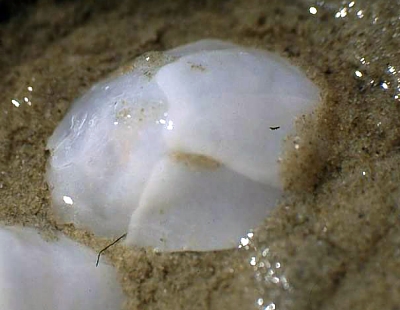
Thanks Julie,
It will be interesting to hear if you find it again. The angle of your photos show the muscular, flattened, wedge-shaped body of this species very well.
Best wishes,
Bill Rudman
Philine angasi from sthn Queensland
November 17, 2008
From: Gary Cobb
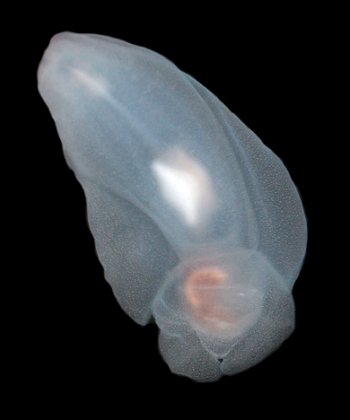
Concerning message #176:
Hi Bill and everyone!
David and I had another great day at Moreton Island. We added another species to our ever growing list ... 354. After a 2 hour dive at the north west side of Flinders reef we drove 'Mischief ' over to the west side of Moreton Island to anchor and have lunch. A friend of mine and I swam over the island and back to the boat. While swimming I noticed the small sea grass patches. Blade lengths were about 100 mm and sand bottom. I decided I should have a better look and got into my gear and went to the bottom which was 8 feet down.
Upon reaching the grass I noticed lots of egg masses on stalks! Just like the egg mass photo on the Philine aperta page. I then proceeded to 'rake' the bottom to see what would happen and then a large white slug appeared!! I then swam around and raked more areas and found dozens of animals.
Richard Willan tells me this species lives it's entire life under the sand eating small crustaceans, only sufacing to spawn.
Locality: Moreton Island, 3 m, Queensland, Australia, Pacific Ocean, 15 November 2008, Subtidal. Length: 13-42 mm. Photographer: Gary Cobb.
Cheers
Gary
gary@nudibranch.com.au
Cobb, G.C., 2008 (Nov 17) Philine angasi from sthn Queensland. [Message in] Sea Slug Forum. Australian Museum, Sydney. Available from http://www.seaslugforum.net/find/22053
Dear Gary,
Thanks for the record. These 'infaunal' species which are only sighted when they are egg laying or dying after being washed ashore are a mystery part of the fauna, for they are seldom seen, and extremely difficult to study. I would be interested to hear from Richard if he has any observations on this species feeding on crustaceans. I studied the feeding biology of this species, and a few others, in New Zealand some years ago and from gut contents and aquarium studies, the only food I could identify was Austrovenus stutchburyi (Gray in Wood, 1828) a quite large bivalve with a heavily calcified shell, which it would crush with its calcified gizzard plates [see message #176]. You can see the bright white gizzard plate in your upper photo. I don't know of any species of Philine which feed on crustaceans, so it would be interesting to have some background information.
Best wishes,
Bill Rudman
On Philine angasi
July 30, 1998
From: Bill Rudman
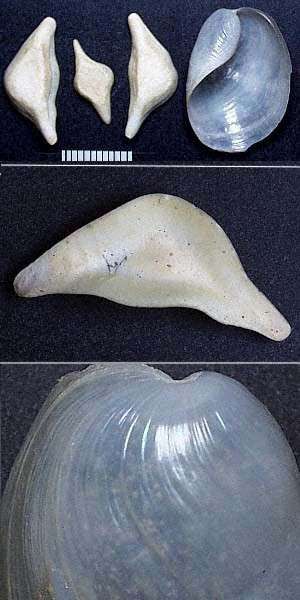
Philine angasi is a relatively large species growing to over 15cm in length. It crushes bivalves with its large calcareous gizzard plates. This species belongs to a group of species, including Philine aperta from Europe and Philine orientalis from the northwest Pacific which have two large plates which are mirror images of each other, and a third smaller plate which is bilaterally symmetrical.
The Upper photo alongside shows that in this species, the two larger gizzard plates are similar in size to the shell (Scale = 10 mm)
The Middle photo shows the two pinholes in the outside of a gizzard plate.
The Lower photo shows the smooth shell lacking any sign of sculpture other than growth lines. Photos: Bill Rudman. (Cheltenham Beach, Auckland, New Zealand, December, 1966).
Further information on the anatomy of this species can be found in:
-
Rudman, W.B., 1970. A revision of the genus Philine in New Zealand with descriptions of two new species (Gastropoda, Opisthobranchia). Journal of the Malacological Society of Australia 2(1): 23-34.
-
Rudman, W.B., 1972a. Structure and functioning of the gut in the Bullomorpha. (Opisthobranchia) Part 3. Philinidae. Journal of Natural History 6(4): 459-74.
-
Rudman, W.B., 1972b. The genus Philine (Opisthobranchia, Gastropoda). Proceedings of the Malacological Society of London, 40(3): 171-87.
Bill Rudman.
Rudman, W.B., 1998 (Jul 30) On Philine angasi. [Message in] Sea Slug Forum. Australian Museum, Sydney. Available from http://www.seaslugforum.net/find/176